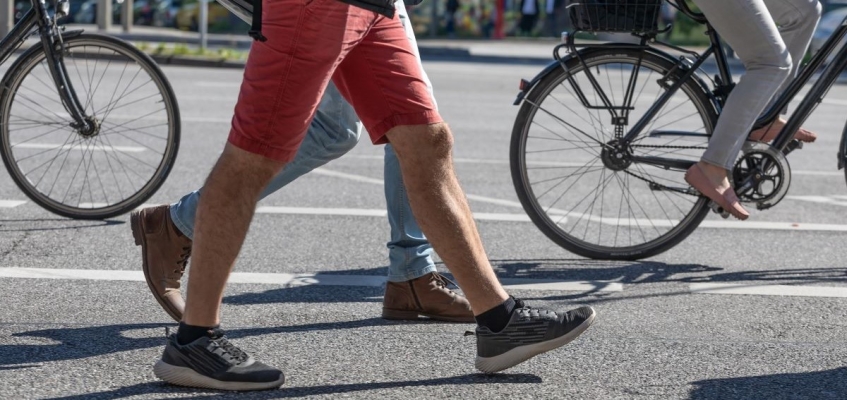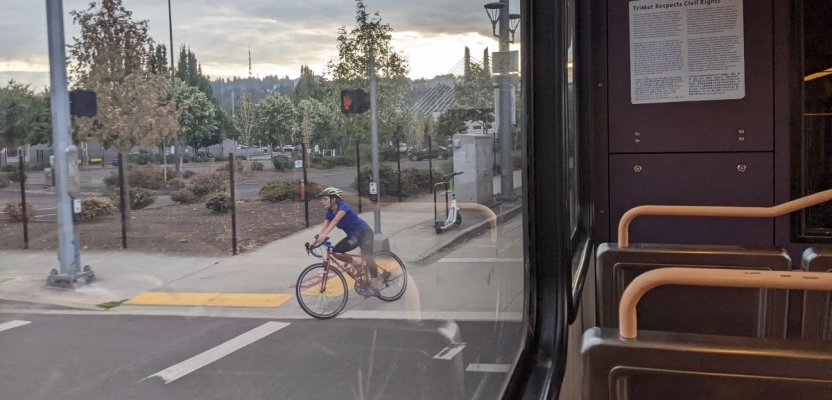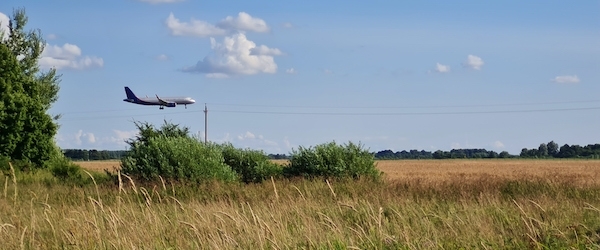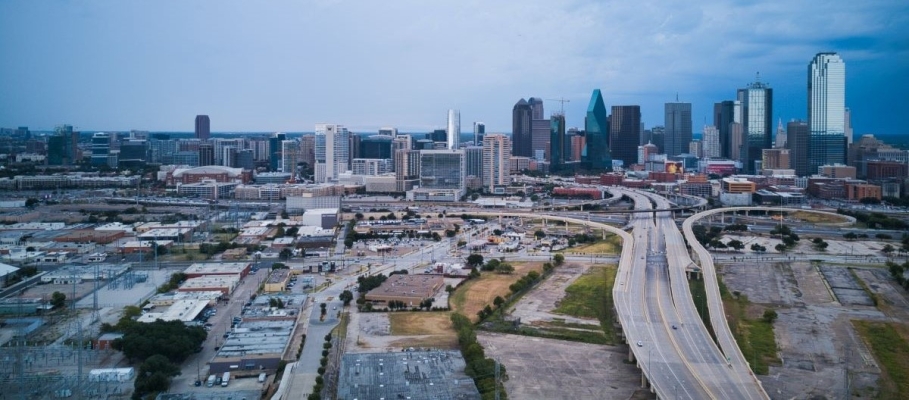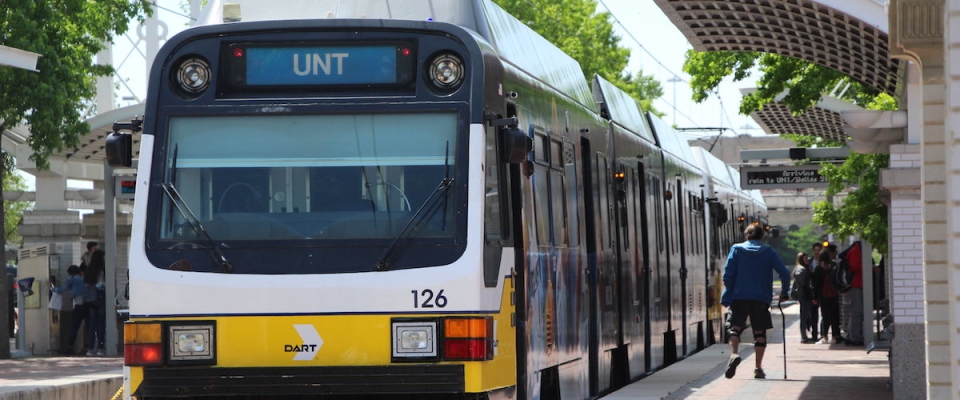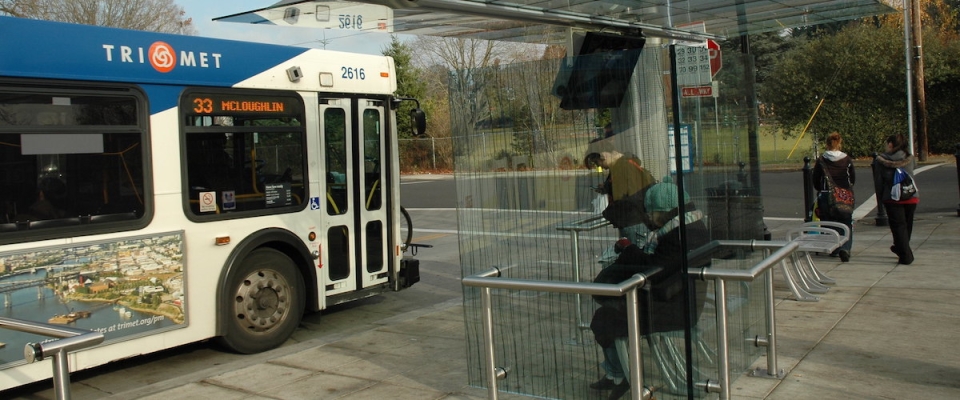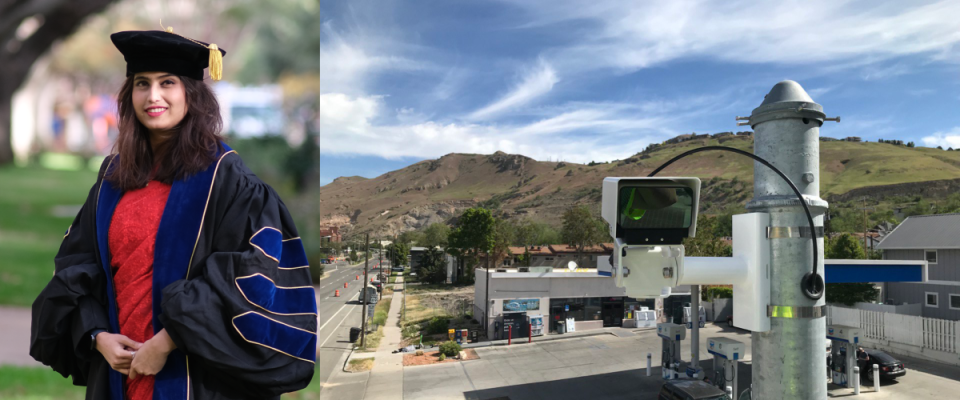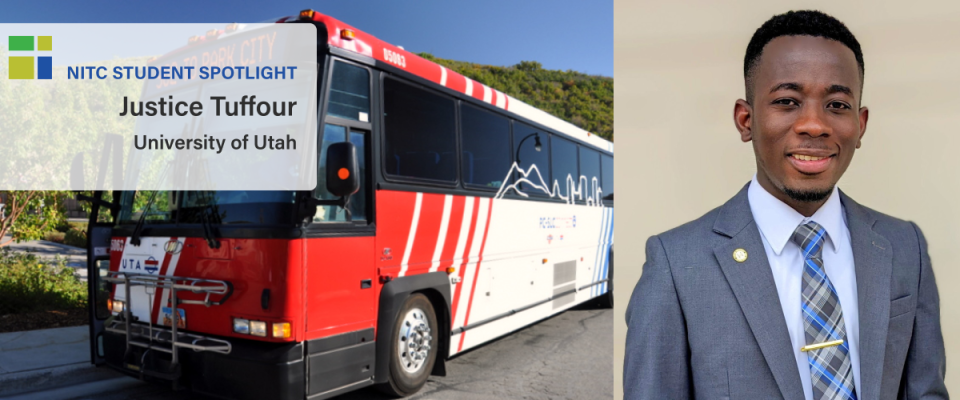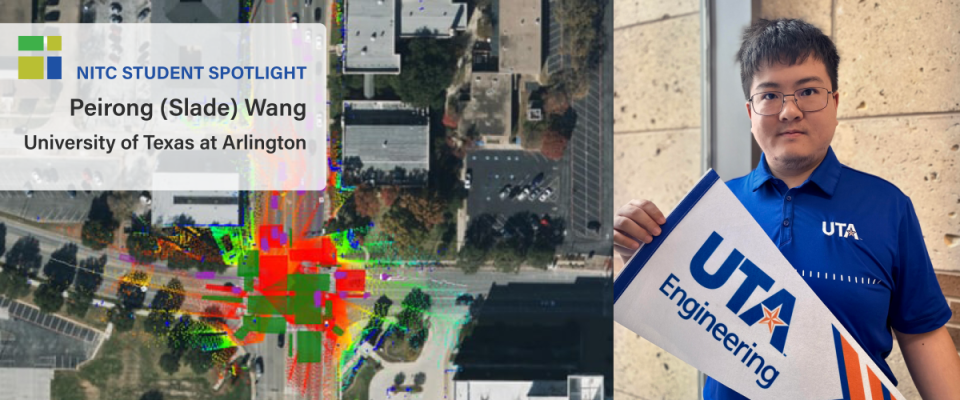As a social determinant of health, transportation significantly contributes to people's well-being. Walkable, bikable, transit-oriented communities are associated with healthier populations. People in such communities are more physically active, less likely to be injured due to a crash, and less exposed to air pollution.
Because of these and other factors, researchers and practitioners have called for health indicators as one way to integrate public health concerns into transportation decision-making. However, it is unclear how indicators are actually being used and what their impact is on policy.
Research conducted by Kelly Rodgers, a National Institute for Transportation and Communities (NITC) Dissertation Fellow, explored how health-related indicators are being used in municipal transportation plans, whether they are institutionalized into transportation agency decision-making processes, and what influence they have on administrative decision-making.
"I have for some time been working at the intersection of health and transportation, and was interested in how health could be better integrated into transportation decision making. And I have also previously done work on performance measures. And so I kind of combined those two things, to see if health-related indicators were a way of getting transportation agencies to consider health in transportation planning," Rodgers said.
THE RESEARCH
Rodgers conducted case...
Read moreLiving in a car-centric society has its downsides, and many transportation professionals are working to encourage non-car travel. To do so, researchers must determine what motivates people to use other forms of transportation besides driving as well as what discourages them. The COVID-19 pandemic lowered the amount of car driving because of stay-at-home orders and the shift to remote work. Researchers from the University of Oregon saw this as the perfect opportunity to work on identifying how travel behaviors changed as a result. Other objectives of the project were to evaluate the prevalence of desire to expand travel options in the future, and to explore any new, post-COVID support for policies that encourage multimodal travel.
This project builds on the 2020 paper, “Moving Eugene Sustainably After COVID-19,” in which the researchers, Yizhao Yang and Rebecca Lewis, found that factors dissuading folks in the Eugene-Springfield region of Oregon from biking or walking pre-pandemic mattered less during the pandemic. For the NITC project, the researchers followed up with the previous interviewees as well as new participants in the Eugene-Springfield area to document how their opinions about transportation have changed since the beginning of 2020. The research refers to three distinct periods of time: Before COVID Emergency Period (before March 8, 2020, when...
Read moreHow can emerging data sources most effectively be integrated with traditional sources? A new article in the July 2023 issue of Transportation Research Record: Journal of the Transportation Research Board reports that rather than replacing conventional bike data sources and count programs, old “small” data sources will likely be very important for big data sources like Strava and StreetLight to achieve their potential for predicting annual average daily bicycle traffic (AADBT).
The article, "Evaluating the Potential of Crowdsourced Data to Estimate Network-Wide Bicycle Volumes," was authored by TREC researchers Joe Broach, Sirisha Kothuri and Nathan McNeil of Portland State University along with Md Mintu Miah, Kate Hyun and Stephen Mattingly of the University of Texas at Arlington, Krista Nordback of the University of North Carolina, Chapel Hill; and Frank Proulx of Frank Proulx Consulting, LLC.
Transportation agencies have invested heavily in count infrastructure and models to estimate motor vehicle volumes through networks. Efforts to develop network wide bicycle volume estimates have been hampered by lack of bicycle counters and limited other data sources from which to draw volume estimates. Until recently, most data on bicycle activity came from national or regional household travel surveys, along with observed counts of cyclists—...
Read morePassenger aviation is a driver of the US economy, contributing over 4% to US GDP every year. While most large metropolitan areas in the United States have easy access to global air transportation networks through major hub airports, residents of small, remote communities may struggle to access such opportunities. To improve access for such communities, Congress established Essential Air Service (EAS), which provides subsidies to airlines to provide service from certain remote communities to larger hubs. While the costs of EAS have been well studied, little to no research has studied the benefits of EAS.
Research conducted by Austin Drukker, a National Institute for Transportation and Communities (NITC) Dissertation Fellow, sought to quantify the benefits of EAS to remote communities in order to understand whether EAS accomplished its goal of connecting these communities to the national air transportation network, or whether Congress should consider other policies to meet this objective.
THE RESEARCH
The researcher posed three main questions:
- How much do remote communities value Essential Air Service?
- How does the value of Essential Air Service compare with its costs?
- Are there...
How do you get from point A to point B? Maybe you bike or take public transit to get to work or school. Perhaps you drive to places that may be farther away, like medical appointments or friends’ houses. Imagine that you didn’t have access to many transportation options—maybe you were unable to drive a car, or the nearest bus stop was several miles away. This is the reality for many folks as they grow older, and their loved ones must then help them get where they need to go.
Older immigrants often live in low-density urban environments, or places where they need to use an automobile of some sort and have limited access to public transportation (like the Dallas-Fort Worth metroplex). This could potentially add stress to both the older folks and the private ride providers who help with transportation. The providers may be at risk for the burden and stress of caregiving, and the older immigrants may lack transportation to important social or health opportunities if the providers they rely on are not available.
Researchers at the University of Texas, Arlington and the University of Connecticut teamed up to fill a gap in the knowledge of the elderly Vietnamese immigrant population in DFW. They sought to learn about the transportation behaviors not only of the Vietnamese adults but also of their ride providers. By increasing knowledge of the transportation...
Read moreNo matter where you live, but especially if you live in a big city, you have likely seen people experiencing homelessness (PEH) using public transportation services. PEH use public transportation not only to get from place to place but also as shelter. Unfortunately, the relationship between the homeless populations, homeless services providers, and transportation providers is not well understood, making it difficult to pinpoint the best ways to accommodate those experiencing homelessness.
Conducted by a research team at the University of Texas, Arlington, the latest National Institute for Transporation and Communities (NITC) project served to determine the needs of people experiencing homelessness in order to advise transportation providers on how to best support this population.
THE RESEARCH
The research team asked four main questions:
- How does Dallas Area Rapid Transit (DART) meet the daily needs of PEH?
- What are the nationwide services provider practices for providing mobility for PEH?
- Why do PEH not use public transit?
- What are the reactions of PEH and homeless services providers to potential transit agency interventions identified in earlier research?
To answer these questions, the research team conducted in-person interviews with willing PEH at a Dallas County homeless services provider. They also gathered data with a quantitative survey...
Read moreIn recent years, there has been a nationwide push to move from using cars to using other modes of transportation. The benefits of active transportation (that is, walking, biking, and even using public transit) are widely known. Not only can these modes of transportation increase people’s physical and mental well-being, but they also cut down on the negative effects of cars (like their contributing to greenhouse gas emissions and air pollution).
In an effort to encourage more people to use public transportation, and to reduce disparities among riders of varying incomes, Portland, Oregon’s TriMet system developed a low-income fare option for its Honored Citizens Fare (HCF) program. The purpose of the paper—titled “Do Travel Costs Matter? Using Psychological and Social Equity Perspectives to Evaluate the Effects of a Low-Income Transit Fare Program on Low-Income Riders”—was to determine if the low-fare option works to increase access to transit and improve well-being among low-income riders in comparison to other riders. If it does, then it is an effective way to identify and meet the needs of this population and distribute the benefits of transportation investments more fairly.
The HCF program reduces the fare of the public transportation that TriMet provides, which includes buses and...
Read moreFarzana Rahman Chowdhury is an associate consultant traffic engineer at WSP USA. She earned a master’s in transportation engineering from Mississippi State University in 2019 and a Ph.D. in civil engineering from the University of Texas at Arlington in summer 2022. Her research focuses on network modeling, traffic engineering, and transportation planning.
Connect with Farzana on LinkedIn
As a PhD student, you worked with Dr. Li on the NITC project "Pedestrian Behavior Study to Advance Pedestrian Safety in Smart Transportation Systems Using Innovative LIDAR Sensors," Tell us about that work?
I worked with Dr. Li on this project as part of my doctoral dissertation. As a part of the project, we installed an industry-level LIDAR sensor at 2 separate intersections in the Dallas-Fort Worth (DFW) region with significant amount of pedestrian traffic. Although only one has voice-assisted infrastructure to help pedestrians cross. This aim of this study was to gather exact pedestrian data using LIDAR sensors and evaluate pedestrian behaviors such perception-reaction time, waiting time, and crossing time at crossings in conjunction with traffic signal statuses.
As an outcome of the research, we proposed a dynamic flash...
Read moreJustice P. Tuffour is a recent graduate of the Master of City and Metropolitan Planning program at the University of Utah. He specialized in smart growth, transportation, land use, and accessibility planning. Justice is a dual recipient of the Department of Planning (CMP) and College of Architecture and Planning (CA+P) scholarships. In the CMP Department, he worked as a Graduate Teaching Assistant and a Research Assistant at the Metropolitan Research Center (MRC). Justice is currently working as a Planner and GIS Technician for the city of Holladay, UT.
Connect with Justice on LinkedIn & Research Gate
Tell us about yourself?
Before moving to the University of Utah during the winter of the 2020 pandemic, I pursued most of my education in Ghana where I obtained a Master of Philosophy degree in Planning, and an honorary Bachelor of Science (First Class) in Human Settlement Planning. Two things that I love are spending time with my family and playing soccer....
Read morePeirong (Slade) Wang is a PhD student in transportation engineering at the University of Texas at Arlington (UTA). He currently works as a graduate research assistant in UTA's ACTION (Advanced Computing in Transportation, Information, Operations and Networks) lab and serves as president of UTA's ITE student chapter. He earned a master's of science from Mississippi State University, where he also worked as a research assistant, and a bachelor's of science from China Agricultural University.
Tell us about yourself?
My name is Peirong (Slade) Wang, and I am currently pursuing my Ph.D. in transportation engineering at the University of Texas at Arlington. Prior to joining UTA, I obtained a bachelor’s degree in both Mechanical Engineering and Electrical Engineering and completed a master’s degree in Civil Engineering. At present, I am working as a graduate research assistant at the ACTION (Advanced Computing in Transportation, Information, Operations and Networks) lab, where I am engaged in cutting-edge research topics related to transportation. Additionally, I have the privilege of serving as the President of the Institute of Transportation Engineers (ITE) student chapter at UTA.
What (or who) has influenced your career path in transportation?
My father, who is a traffic...
Read more
